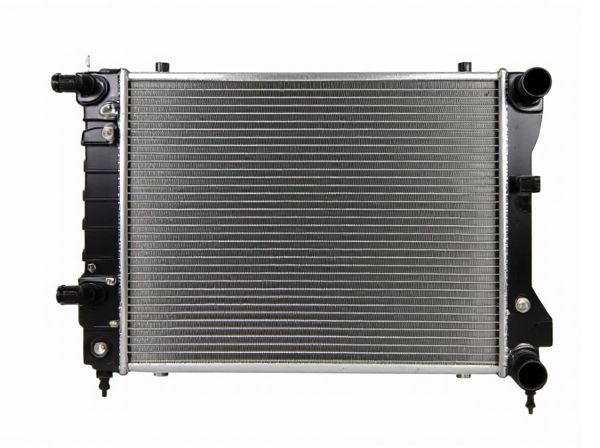
Photo illustration: Two Row Radiator vs Three Row Radiator
Two row radiators offer a more compact design, making them ideal for vehicles with limited engine bay space or for those seeking improved airflow. Three row radiators provide enhanced cooling capacity by increasing the surface area, which is beneficial for high-performance or heavy-duty applications where heat dissipation is critical. Choosing the right radiator depends on your vehicle's cooling needs and available space under the hood.
Table of Comparison
| Feature | Two Row Radiator | Three Row Radiator |
|---|---|---|
| Cooling Efficiency | Moderate cooling capacity suitable for standard engines | Higher cooling capacity ideal for high-performance or heavy-duty engines |
| Size & Weight | Compact and lightweight, easier to install | Larger and heavier, requires more space |
| Cost | Generally more affordable | Higher price due to increased cooling capability |
| Heat Dissipation | Less surface area, moderate heat dissipation | More surface area, superior heat dissipation |
| Ideal Usage | Daily driving and light-duty vehicles | Performance cars, towing, and heavy-duty applications |
Introduction to Radiator Rows
Radiator rows refer to the number of horizontal tubes stacked to increase the cooling surface area in automotive cooling systems. A two-row radiator offers moderate heat dissipation suitable for standard vehicle engines, while a three-row radiator provides enhanced cooling capacity by expanding the contact area for coolant and airflow. The choice between two-row and three-row radiators depends on engine size, vehicle performance requirements, and ambient operating conditions.
How Radiator Rows Impact Cooling Efficiency
Two row radiators provide moderate cooling efficiency suitable for standard vehicle engines, as the reduced surface area limits heat dissipation. Three row radiators increase cooling capacity by offering greater surface area, enhancing heat transfer and maintaining optimal engine temperatures under heavy loads or high-performance conditions. Selecting the appropriate radiator row count directly influences engine cooling efficiency, impacting overall vehicle performance and longevity.
Design Differences: Two Row vs Three Row Radiators
Two-row radiators feature two stacked rows of cooling tubes, offering a compact design with sufficient heat dissipation for moderate engine loads, while three-row radiators incorporate an additional row to significantly increase surface area and cooling capacity. The three-row design enhances thermal efficiency, making it ideal for high-performance or heavy-duty vehicles that generate more heat. However, the increased thickness of three-row radiators requires more space in the engine bay and may necessitate modifications for fitment.
Heat Dissipation Capabilities Compared
Two row radiators provide efficient heat dissipation with moderate cooling surface area, suitable for standard engine cooling demands. Three row radiators offer significantly increased heat dissipation capabilities due to their larger core thickness and enhanced coolant flow capacity, making them ideal for high-performance or heavy-duty applications. Despite the added weight and potential airflow restriction, three row radiators maintain lower engine temperatures under intense conditions, optimizing overall cooling efficiency.
Performance Impacts in Real-World Driving
Two row radiators provide sufficient cooling capacity for moderate engine loads and urban driving conditions, ensuring stable temperatures during stop-and-go traffic. Three row radiators offer enhanced thermal dissipation, improving performance under heavy loads, high-speed driving, or towing by preventing overheating and maintaining optimal engine efficiency. Real-world driving shows three row radiators extend engine lifespan in demanding scenarios by reducing heat soak and supporting consistent cooling flow.
Space and Fitment Considerations
Two row radiators offer a more compact design, making them ideal for vehicles with limited engine bay space or tight fitment requirements. Three row radiators provide increased cooling capacity but require additional clearance, which may interfere with other engine components or mounting points. Careful measurement of available space and consideration of airflow paths are essential to ensure proper fitment and optimal cooling performance.
Cost Comparison: Two Row vs Three Row
Two row radiators typically cost less than three row radiators due to their smaller size and lower material requirements, making them a budget-friendly option for vehicles with moderate cooling needs. Three row radiators demand higher manufacturing costs because of the additional cooling tubes and increased complexity, which translates to a higher purchase price but better heat dissipation for high-performance engines. Vehicle owners should weigh the upfront cost difference against potential long-term benefits in cooling efficiency and engine protection when choosing between two row and three row radiators.
Durability and Maintenance Factors
Two row radiators generally offer easier maintenance due to their compact design allowing simpler access for cleaning and repairs, while three row radiators tend to provide increased durability with enhanced cooling performance under heavy load conditions. The thicker core of a three row radiator reduces overheating risks, prolonging engine life in demanding environments, but may require more frequent deep cleaning to prevent clogging. Choosing between the two depends on balancing the need for sustained durability against maintenance convenience in specific vehicle applications.
Ideal Applications for Each Radiator Type
Two row radiators excel in compact engine bays where moderate cooling is sufficient, making them ideal for everyday vehicles and light-duty trucks that operate primarily in mild to moderate climates. Three row radiators provide superior heat dissipation suitable for heavy-duty trucks, performance vehicles, and off-road machinery exposed to high engine loads or extreme temperatures. Selecting the appropriate radiator type ensures optimal engine temperature management based on vehicle use and operating environment.
Which Radiator Row is Best for Your Vehicle?
Two row radiators offer a balance of efficient cooling and compact size, making them ideal for standard vehicles with moderate engine heat output. Three row radiators provide enhanced cooling capacity suitable for high-performance or heavy-duty vehicles that generate significant heat under demanding conditions. Choosing the best radiator row depends on your vehicle's engine size, typical driving conditions, and cooling system requirements.
 caratoz.com
caratoz.com